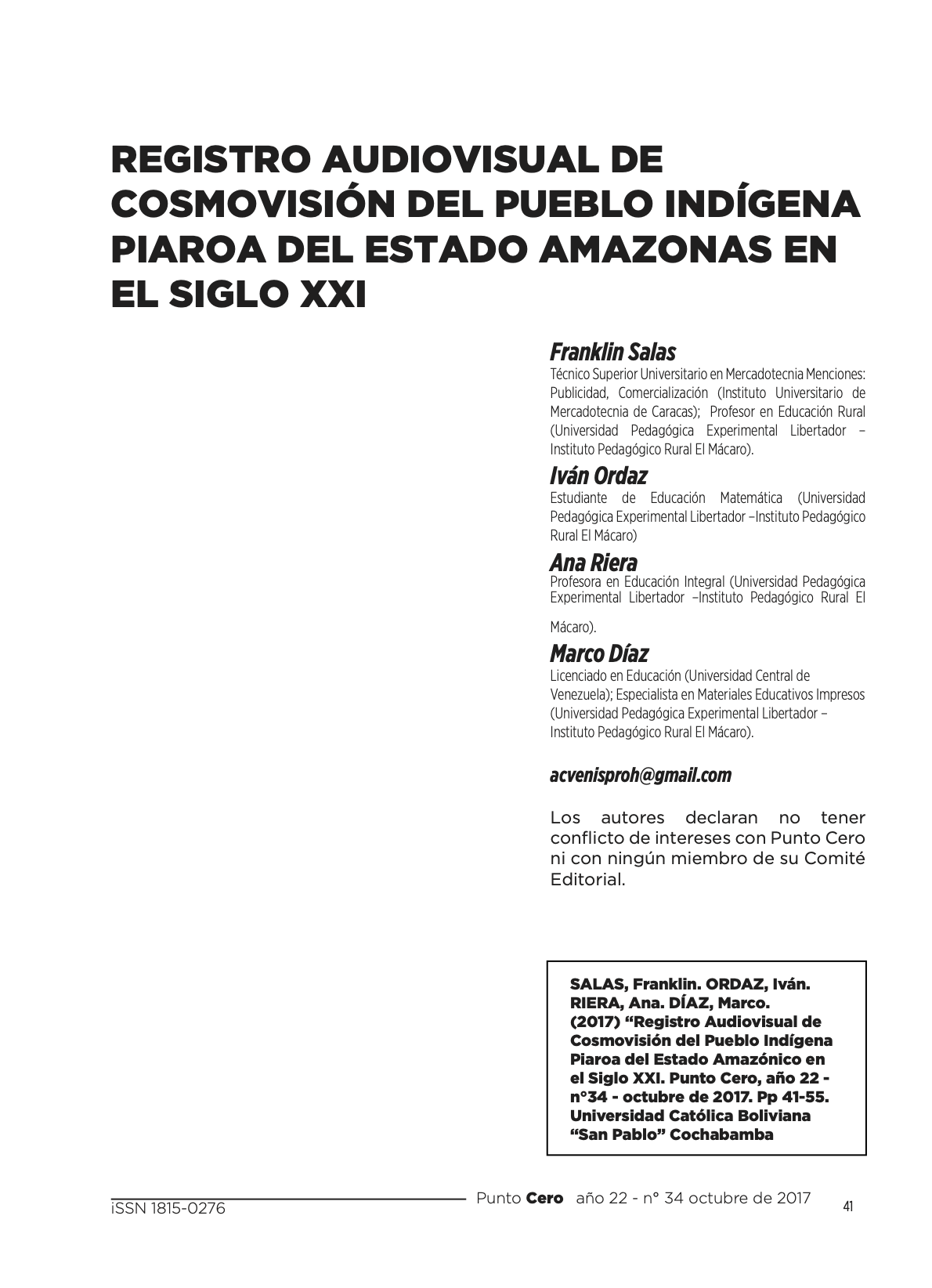Registro audiovisual de cosmovisión del pueblo indígena Piaroa del Estado Amazonas en el siglo XXI
DOI:
https://doi.org/10.35319/puntocero.20173478Palabras clave:
Registro Audiovisual, Pueblo Piaroa, Gastronomía, Siglo XXIResumen
El propósito fue Desarrollar un registro audiovisual para difusión de la Cosmovisión Gastronómica del Pueblo Indígena PIAROA del estado Amazonas en el contexto del siglo XXI. Se sustenta en lo establecido en la Constitución (1999) y marco legal referido a la corresponsabilidad en registro y difusión de conocimientos ancestrales indígenas y por Lara (2012) al decir: “Los piaroa, entre otros, están afectados por transculturización y tradiciones ajenas. Por tanto, registrar y difundir materiales que fortalezcan el conocimiento de estos pueblos es vital”. (p.34). Modalidad de Proyecto especial, cuantitativa, carácter descriptivo, estudio campo y revisión documental. Técnica: Entrevista y Guión de Entrevista como Instrumento. La población fue: un docente con Doctorado; un Cheff profesional acreditado y conocedor de los Piaroa, un Propietario de Restaurant Popular; Dos Integrantes del Pueblo Indígena Piaroa. La muestra de carácter censal. Los resultados reportan que el contexto geo-social conlleva predominio multicultural (Piaroa, Criollo, Colombiano y Brasilero) que nutre de matices a la gastronomía del pueblo Piaroa en el siglo XXI. Se registró expresiones culinarias propias del Pueblo Piaroa: Preparación de Araña Mona, Ajicero, Bachaco Culón, Casabe y Yukuta. Con base a ello, se diseñó un Prototipo de Video audiovisual para la difusión de la Cosmovisión Gastronómica del Pueblo Indígena Piaroa en el contexto del siglo XXI. Se recomienda, procurar la difusión en plataforma Youtube y sensibilizar a los docentes de las Instituciones educativas en relación a la utilización del video como material educativo. El video se encuentra disponible en el siguiente link: https://youtu.be/ L43fPBDPz_E
Citas
ARETZ, Y. (1999) La memoria del folclore americano. [Documento en línea] Disponible: https://www.lanacion.com.ar/espectaculos/musica/isabel-aretz-la-memoria-del-folklore-americano-nid396379/ (Consulta: agosto de 2016)
ARIAS, F. (2011) El proceso de Investigación. Episteme: Caracas
BEJARANO y Otros (2014) Investigación para la elaboración de guión para documentales. Escuela Superior Politécnica del Litoral de Ecuador. Disponible: https://www.dspace.espol.edu.ec/bitstream/123456789/7836/1/Investigaci%C3%B3n%20para%20la%20elaboraci%C3%B3n%20del%20gui%C3%B3n%20para%20documentales.pdf
CONSEJO LEGISLATIVO DEL ESTADO AMAZONAS, VENEZUELA (2002) Cons- titución. Promulgada por el Consejo Le- gislativo.- Puerto Ayacucho; doce (12) días del mes de Septiembre del año dos mil dos (2002). Años: 192o de la Independencia y 143o de la Federación. Disponible: http://www.acnur.org/fileadmin/scripts/doc.php?file=fileadmin/Documentos/BDL/2008/6640
DE CARVALHO, P. (1989) Diccionario de Teoría Folklórica: Folklore General: Ecuador
DOMÍNGUEZ, C. (1999). “Espacio, territorio y frontera: reconceptualización para un curriculum integrado”. Un curriculum de Ciencias Sociales para el siglo XXI. Logroño. Universidad de la Rioja.
FONDO MULTILATERAL DE INVERSIO- NES (2017) Guía de materiales audiovisuales. Grupo del Banco Interamericano de Desarrollo. Disponible: https://publications.iadb.org/publications/spanish/document/El-Fondo-Multilateral-de-Inversiones-Lecciones-aprendidas-en-el-establecimiento-de-una-industria-local-de-capital-emprendedor-en-Latinoam%C3%A9rica-y-el-Caribe.pdf
GRUNDY, H. (1991), Producto o praxis del curriculum: Cuadro sobre elementos e intereses fundamentales. [Documento en línea] Disponible: https://www.fceia.unr.edu.ar/geii/maestria/2013/Brovelli%20Curriculum%20Dise%C3%B1os,%20Teor%C3%ADas%20y%20Evaluaci%C3%B3n/Producto_o_praxis_del_curriculum%20GRUNDY.pdf (Consulta: julio de 2016)
HERNÁNDEZ R. y otros (2016) Metodolo- gía de la Investigación. 6 ta. Edición. México: Mc. Graw Hill.
INSTITUTO NACIONAL DE ESTADÍSTICA INE- (2011) Censo Poblacional 2011. Dis- ponible: www.ine.gov.ve/
LARA (2012) Expresiones tradicionales de los pueblos indígenas del estado Amazonas. Ensayo Doctoral. UPEL: Extensión Amazonas. Disponible: www.iprem.upel.edu.ve
LASALA, C. (2009) Guía para elabora- ción de Proyectos audiovisuales. Disponible: http://webdelprofesor.ula.ve/humanidades/raymond/wp-content/uploads/2016/02/proyectos-audiovisua-les.pdf
MINISTERIO DEL PODER POPULAR PARA LA EDUCACIÓN (2009) Proyecto educativo nacional 2009 [Documento en línea] Disponible: http://www.me.gob.ve (Consulta: agosto de 2016)
PAREDES, L. (2011) Características de una metodología audiovisual. Jefe del Departamento de Artes Plásticas y tecnología educativa. Universidad de Carabobo. Venezuela. Disponible: http://servicio.bc.uc.edu.ve/educacion/revista/a1n2/1-2-12.pdf
RAMOS Y JIMÉNEZ (1997) Desarrollo: lo educativo, lo social. [Documento en línea] Disponible: http://www.educares.com.cl (Consulta: octubre de 2016)
REPÚBLICA BOLIVARIANA DE VENEZUELA (1999) Constitución. Gaceta Oficial No 36.860 del 30 de diciembre de 1999).
REPÚBLICA BOLIVARIANA DE VENEZUELA (2005) Ley Orgánica de Pueblos y Comunidades Indígenas. Gaceta Oficial No. 38.344. Caracas: Asamblea Nacional
SABINO, C.(1992) El proceso de Investiga- ción. Panapo: Caracas.
Sichra, Inge y López (2003) Interculturalidad, educación y Ciudadanía. Perspectivas latinoamericanas. Plural Editores: Ecuador.
TOUKOMAA Y SKUTNABB-KANGAS (1977) Working Papers of bilingualism. [Docuemnto en línea] Dep Education. University jyvalskyla . Disponible: https://books.google.co.ve/books?id=SSJcw-1JB2RkC&pg=PA189&lpg=PA189&dq=-Toukomaa&source=bl&ots=I0wdqES-0Ci&sig=cgDB6kRWlsN8MyyZ8pqTi-6v6LX8&hl=es&sa=X&ved=0ahUKEwj-mwdrd8qLWAhUoKpoKHWvwCMw-Q6AEIWjAN#v=onepage&q=Toukomaa&-f=false. (Consulta: agosto 2016)
TUBINO, F. 2002. “Entre el multiculturalismo y la interculturalidad: más allá de la discriminación positiva”. En N. Fuller, (ed.), Interculturalidad y política. Desafíos y posibilidades. Lima: Red para el Desarrollo de las Ciencias Sociales en el Perú. 51-76.
UNIVERSIDAD EXPERIMENTAL PEDAGÓ- GICA Libertador (2013) Manual de Trabajos de Grado, Maestría y Tesis Doctorales. Caracas: fedeupel
YAVINAPE, R. (2015) Guía de criterios para la promoción de la cosmovisión Yeral/ Ñeengatu en el Subsistema de Educación Primaria, dirigida a docentes de la U.E. San Pedro Alejandrino, Municipio Autana del estado Amazonas. Disponible: www.iprem.upel.edu.ve

Descargas
Publicado
Cómo citar
Número
Sección
Licencia
Derechos de autor 2017 Revista Punto Cero

Esta obra está bajo una licencia internacional Creative Commons Atribución-NoComercial 4.0.








